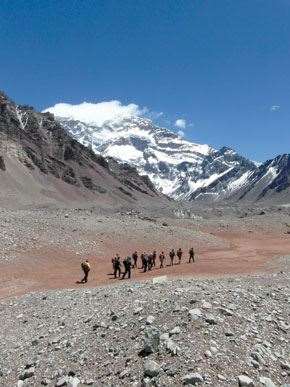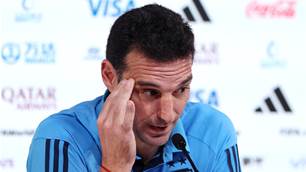Climbing a high mountain produces scant adrenaline and offers little in the way of thrills. Instead it’s all about discomfort;
 photos by AARON SCOTT
photos by AARON SCOTTIf the cold made itself known at pre-base camp, then the first signs of altitude appear at Plaza de Mulas, 1000m higher up. The walk there is a 20km grind along the immense stone gouge of the Horcones Valley. The thorn bushes disappear, replaced by fields of scree and uplifted strata of rock, stained a sulphurous yellow or coppery green. At points we come on the carcasses offallen mules, the bones picked clean by condors. There’s the eerie sense of the mountains closing in around us. We all feel it except Leandro, the sole Argentinean climber, who wanders along singing opera at full volume.
Base camp sprawls across the head of the valley in a grey cup of glacial moraine bounded on three sides by sheer walls of rock. It’s an odd, scruffy place. Hot showers can be had for $10, internet can be checked for $1 a minute, but filthy climbers wander aimlessly, packing and repacking their kit, tying and retying their crampons, drinking endless cups of tea, and casting sidelong glances at Aconcagua to the east. The summit ridge is clearly visible, three kilometres above. In the rarefied air it looks as if it could be reached in an afternoon’s walking. We arrive at base camp to find more tables laden with obscene amounts of food and drink. All of us descend on the tables, with the exception of Leandro, who stumbles off to his tent, clutching his forehead, his face a burning red.
I shake my head and laugh, but two days later, after an acclimatising climb to the peak of Cerro Bonetti, a 5100m cone of scree standing five kilometres from base camp, I’m struck low by altitude. As we plod back into camp, the space behind my forehead suddenly fills with a molten pain. I down three mugs of cordial and the pain abruptly recedes. Half an hour later I stumble out of the toilet, burying the heels of my palms into my eye sockets. The pain has returned with a ferocity that sends flashes of light across my eyelids. I down another three mugs of cordial, then stagger silently to my tent, Leandro’s laughter at my back.
It was only by the end of the 19th Century that alpinists began descending on Aconcagua to stand on the roof of the Americas. In 1883, a 43-year-old Berliner with outstanding facial hair, called Paul Gussfeldt, launched the first attempt at the summit of the mountain. His climbing style was cavalier. After establishing a camp at 5000m on the western face, he dumped his tent, bedding and excess food and, wearing a woollen suit with a silk scarf tied jauntily around his neck, made a headlong dash for the summit. He was within 500m of the peak when an exfoliating southerly stopped him in his tracks. Gussfeldt was a veteran of the European Alps, but he’d never seen a wind like this. Battered and bewildered, he turned around. “Such suffering makes it impossible for any human being to reach the summit,” he later surmised in his journal.
We’re standing in the spot where Gussfeldt likely penned those words. It’s Plaza Canada, the first high camp, a 5000m-high knob of scree partly shaded from the wind by a ragged citadel of rock. We’ve spent the night here and now we’re moving on to Nido de Condores, the second high camp (5500m). We’re fully kitted in our heavy jackets, down mittens, mountain pants, plastic boots, gaiters. The mules go no higher than base camp, so we’re shouldering our own food, our own gear. Our packs weigh 20kg, helmets and sleeping mats tied to the outside. Martin gathers us for another pep talk: “Okay guys, from now on things are going to get harder ... ” We’ll be eating where we sleep, drinking melted snow, shitting in plastic bags. Martin levels his index finger at his temple. “You need to be strong in the mind, yeah? I’m telling you, climbing this mountain is 20 per cent in the body and 80 per cent in the mind.”
I soon discover what he means. At the second high camp, at some dark hour after midnight, I’m woken by the wind battering our tent. I sit up in a blind panic, convinced I’m suffocating, convinced I can’t suck the mountain air into my lungs. In the absolute blackness of night, the only noise the wind whipping the walls of the tent, the fear is horribly claustrophobic. I gape like a landed fish, fighting the terror. Although I suck down lungfuls of air, I can’t dispel the feeling that I’m dying for want of oxygen. I lie in my sleeping bag, sweat on my chest, my feet numb with cold, and stare at the shuddering walls of the tent, suppressing a desperate urge to rush back down to base camp, back where the air is thick.
The next day we wake to find an immense southerly tumbling off the high reaches of the mountain. It’s difficult to describe the dimensions of this wind. It arrives in gusts, rolling down the mountain with a noise like eight-foot surf breaking on a headland, before hitting our camp with a blow that makes my head ache. Walking into this wind is like wading upriver, talking into it is an impossibility, squatting down and relieving yourself into a plastic bag doesn’t bear thinking about. It blows hard for three-straight days.
All this time we sit in our tents. The battery on my iPod dies. I finish my book. I lie in my sleeping bag, watching the minutes tick away, listening to the gusts as they shred the flysheet of our tent. It’s beyond torturous. The boredom magnifies every discomfort. My lips crack and bleed constantly. My wind-burnt hands bubble into blisters that itch relentlessly. My oxygen-starved brain hisses with a persistent ache. My bloated gut knots and then loosens, sending me scuttling outside with a toilet bag every few hours. The tent reeks, the water’s foul, stocks of toilet bags run low. And still the southerly crashes down off the mountain with the noise of breaking surf. Sometime in the afternoon on the third day, my tent-mate Ben props onto his elbow. He stares at me for a handful of seconds, then mutters, “This is fucked, mate. Absolutely fucked.”
Related Articles

Socceroos coach says Argentina can only 'play two ways'

Argentina coach on 'inferior' Socceroos: 'I don't fully agree'













